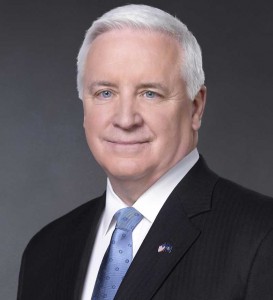Governor’s budget to have little impact in short term, could be major problem in coming years
By Mike McGann, Editor, UnionvilleTimes.com

Gov. Tom Corbett's budget proposal would mean steady funding for the Unionville-Chadds Ford School District for 2012-13, but a new structure for state aid would mean aid would not grow with expenses over the coming years, pushing more burden onto real estate taxes.
EAST MARLBOROUGH — While Gov. Tom Corbett’s budget proposal doesn’t appear to have a short-term negative impact on the local school budget — state funding for 2012-13 is proposed to be about the same as this year — school officials did say Monday night that cutting the proposed district budget will mean further layoffs.
Superintendent of Schools Dr. John Sanville told the Unionville-Chadds Ford Board of Education during its Finance Committee meeting that cutting the budget $775,000 means cutting 10 teachers, or 3% of the teaching staff, or 20 support personnel, a year after 10 support personnel were cut. Currently, the proposed budget calls for using a pension exception to go above the state Act 1 Index — 1.7% — for a tax increase in Chester County.
“This isn’t intended to be a scare tactic or to have people worried about their positions,” Sanville said. “It is important for us to realize that that if we’re looking at the index, that the cuts are mostly going to be in people. That’s the reality.”
But even all the news about Corbett’s budget wasn’t good. If his restructuring plan is approved by the state legislature, basic education, transportation, Social Security reimbursement and the accountability block grant are all being merged into one line item the Student Achievement Education Block Grant. While the new structure adds just under $10,000 to state funding for the 2012-13 year, by detaching the transportation and Social Security funding from actual dollars spent, school officials feel Corbett’s plan ultimately will lead to net cuts in state funding over the next few years.
“State funding as a percentage of our funding is going to decrease,” Sanville said of the years following 2012-13, if the Corbett plan is approved as presented.
Furthermore, financial projections by the district based on these numbers suggest that hewing to the Act 1 limit could lead to a financial tsunami — assuming continued struggles in the local economy — leading to a multi-million dollar budget deficit by the end of the 2017-18 school year. A second set of projections that allows the district to raise taxes at rate of 3.71% has a vastly different outcome: after a couple of years of having to dip into fund balance, the district would be able to maintain and ultimately rebuild the fund balance, projecting roughly a $3 million surplus by 2017-18, needed to replenish the fund balance.
The net difference between the two scenarios in terms of fund balance is about $19 million, due to the cumulative effect of revenue increases — much like compounding interest.
Sanville said he was looking for guidance from the board on how to proceed — and what options should be put on the table, from four-day school weeks, early retirement incentives, cutting the school year from 182 to 180 days, to asking for givebacks from the district’s various bargaining units and looking at selling real estate the district owns near schools.
There was some good news — at least for the coming budget: the Interim Tax is running well above the estimate of $100,000, and is likely to be in the range of $250,000, according to the district’s Director of Business and Operations, Robert Cochran. He said he feels its likely that the number will be repeated in 2012-13, and the budget revenue can be raised accordingly.
“I think that’s a realistic figure as we go forward,” he said.
The administration will prepare various scenarios — based on further input from the baord and the public, starting with the formal school board meeting Feb. 27, followed by the Feb. 29 Community Conversation on district goals and continuing in the formal budget hearings, which are slated to start March 12. The board must give preliminary approval to the final budget in May, with final approval in June.
The preliminary budget, approved in January, calls for a 3.71% tax increase in Chester County (because of differences in real estate valuation, the tax rate in Delaware County is actually going down) and the district applied for exceptions to the Act 1 limit of 1.7% for pension costs.








Keith and Vic: thanks for taking the time to explain the issues. I truly appreciate it.
Keith: if memory serves, when the teacher’s contract was being discussed, Bob Cochran ran various projections on the cost of the contract and it was stated at the time that, using conservative projections on what the Act 1 index might be, that the contract would be sustainable without tax increases in excess of Act 1 amount without exceptions. Projected increases in the costs of health insurance and PSERS contributions were, I assume, factored into Mr. Cochran’s numbers. That’s why I am rather surprised to hear about potentially going millions in the debt over a few short years without layoffs or larger tax increases. This seems especially surprising in light of the relatively minor reduction in work force (paraprofessionals) that took place last year. I would have thought that actually strengthened the likelihood Mr. Cochran’s projections bearing out.
Observing,
.
Please realize that small percentage differences in revenue or expenditures drive large fund balance differences in year 5 of the projection. For instance, let’s assume we let expenditures grow just a half-percent faster than revenues each year for 5 years on a $70M budget. In year 1 we’re short by $350K; in year 2, $700K, in year 3, $1.05M, etc. The effect on the fund balance, though, is cumulative. At the end of 5 years the fund balance has decreased by $5M.
.
I’ll note that it’s difficult, almost impossible, to make good projections accurate to 1% or even 2%. Mr. Cochran’s projections are valid at the time they are made, but there are so many variable that can change. The one big change between the September projection and the current projection is the drop in projected Interim Taxes (taxes from new home construction)
.
The large “levers” the board has to respond to budget surprises are the RE tax rate, staffing levels and employee compensation.
Observing,
In addition to Mr. Knauss’ observations, consider this: The projections assume a 8.5% annual increase in the District’s healthcare expenses for employees. They also assume that the District’s share of contributions to the Public School Employees Retirement System – The plan that District educators and administrators participate in – will increase at a double-digit rate over the next several years. So, if you assume a 1.7% increase in revenue on a $73 milllion total (around $1.2 million), and a 10% increase on the overall benefits portion of the District’s compensation budget (about $12 million, so 10% is $1.2 million), you are already at a break-even point BEFORE you factor in salary increases and other budgeted expense increases.
While the State subsidy is a reatively small part of our overall revenue, any increases or decreases in this subsidy have a dramatic impact on the budget margin described above. Given that this year’s state budget took a huge slice out of Higher Education (college) subsidies (well over 20% cut from last year’s subsidy), we are bracing for what might come our way in the next budget cycle.
Observing,
A few points –
– the block grant from the state is not a major factor for the UCF district. The block grant is $5M out of a total budget of $70M. If the block grant remains flat in future years it has only a minor effect on the fund balance.
– the two major factors that drive the fund balance are the yearly increase of the RE tax (80% of our revenues or $58M) and the yearly increase of employee compensation (70% of our expenditures or $51M)
– In general, if we increase employee compensation faster than we increase RE taxes then we’ll have an operating deficit and a decreasing fund balance. Likewise, if we increase RE taxes faster than employee compensation then we’ll have an operating surplus and an increasing fund balance.
– RE tax increases are under the control of the school directors; employee compensation is negotiated in concert with the teachers.
I’m confused and feel like I am missing something here. I was under the distinct impression that with the last teacher’s contract, and assumed continued state funding at the same level, that the district was sustainable over the balance of the teacher’s contract with tax increase at or lower then the projected Act 1 index. The article indicates that this would appear to be true for next school year (2012-13), but then indicates that there is a concern that the state funding will be reduced in 2013-14) because of the “structure” of the funding.
I truly don’t understand how a change from specific block grants to one general grant could lead to a projected multi-million dollar shortfall in a few years, especially when the state’s funding level for the school has never (to my understanding) exceeded one million dollars in a given year.
Furthermore, what assumptions are being used to create these numbers? How can we know what the district’s per-teacher expense is going to be under the next contract or how many students will be in the schools four years from now?
Actually, it’s pretty simple. Under the proposed new structure, the state aid that kept pace with Social Security reimbursement year-to-year, matching 50% of the cost based on payroll, will in essence become a permanent flat number. So anything beyond a permanent wage freeze for all UCF would mean erosion. The same is true for Transportation subsidy. Fuel costs increase, but the state aid to cover such costs does not.
So the district is assuming that the general grant will never go up or just not go up as much as before? Just because it is a general grant doesn’t mean it cannot go up more in the future.
The assumption appears to be flat state aid numbers. If you look at the overall trend in state aid over the last 30 years, aid as a percentage of spending is down a great deal. It is equally possible that projecting flat numbers is overly optimistic as it is overly pessimistic.
I appreciate the insight, Mike. I still don’t see how a “flat” general grant over the next few years gets us millions in the hole. If we got no money at all and used the surplus it would still take 3-4 years to get in arrearages. The district has not reduced the surplus in the last few years and if memory serves it has gone up slightly.
Well, the fund balance is expected to be $4.8 million, or about 7% of the budget. A certain amount needs to be there to keep the bonding and credit folks happy. The big growth comes in the projection comes from a combination of less relative state aid to expense and increases in pension costs/health care costs.